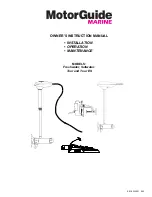
UG:118
vicorpower.com
Applications Engineering: 800 927.9474
Page 2
Set Up
The Customer Evaluation Board should be set up as follows:
Note:
Care should be taken to avoid reversing polarities if connecting to the opposite
(solder) side of the board.
+IN, –IN
Connect a high-quality, low noise power supply to the +IN and-IN terminals of the
Customer Evaluation Board. The startup slew rate of the input source should be no
greater than 1 V/µs. The interconnect leads should be heavy gauge and as short as
possible. Additional capacitance may have to be added on the evaluation board to
make up for impedances in the interconnect leads as well as deficiencies in the source.
+OUT, –OUT
The load should be connected to +OUT and –OUT terminals of the evaluation board
with short leads of suitable gauge to carry the output current and minimize losses. The
evaluation board can be connected directly to the application for which the module is
intended. However the interconnect impedances between the evaluation board and the
application can greatly affect the transient response. For applications where transient
response is critical, the user should consider mounting the HDC module directly to
the target application PCB. Test points TP14 (+OUT) and TP06 (-OUT) can be used to
monitor the output.
Primary Control (PC)
The PC can be used to disable the HDC or provide a primary referenced bias supply. The
module can be disabled by connecting PC (TP03) to –HDC_IN (TP05).
Trim (TR)
The S01 switch on the Customer Evaluation Board can be used to enable or disable
output voltage trimming on the HDC. Potentiometer R12 can be adjusted to trim the
output voltage of the converter.
Figure 1.
HDC Customer Evaluation Board
layout drawing, component side
























